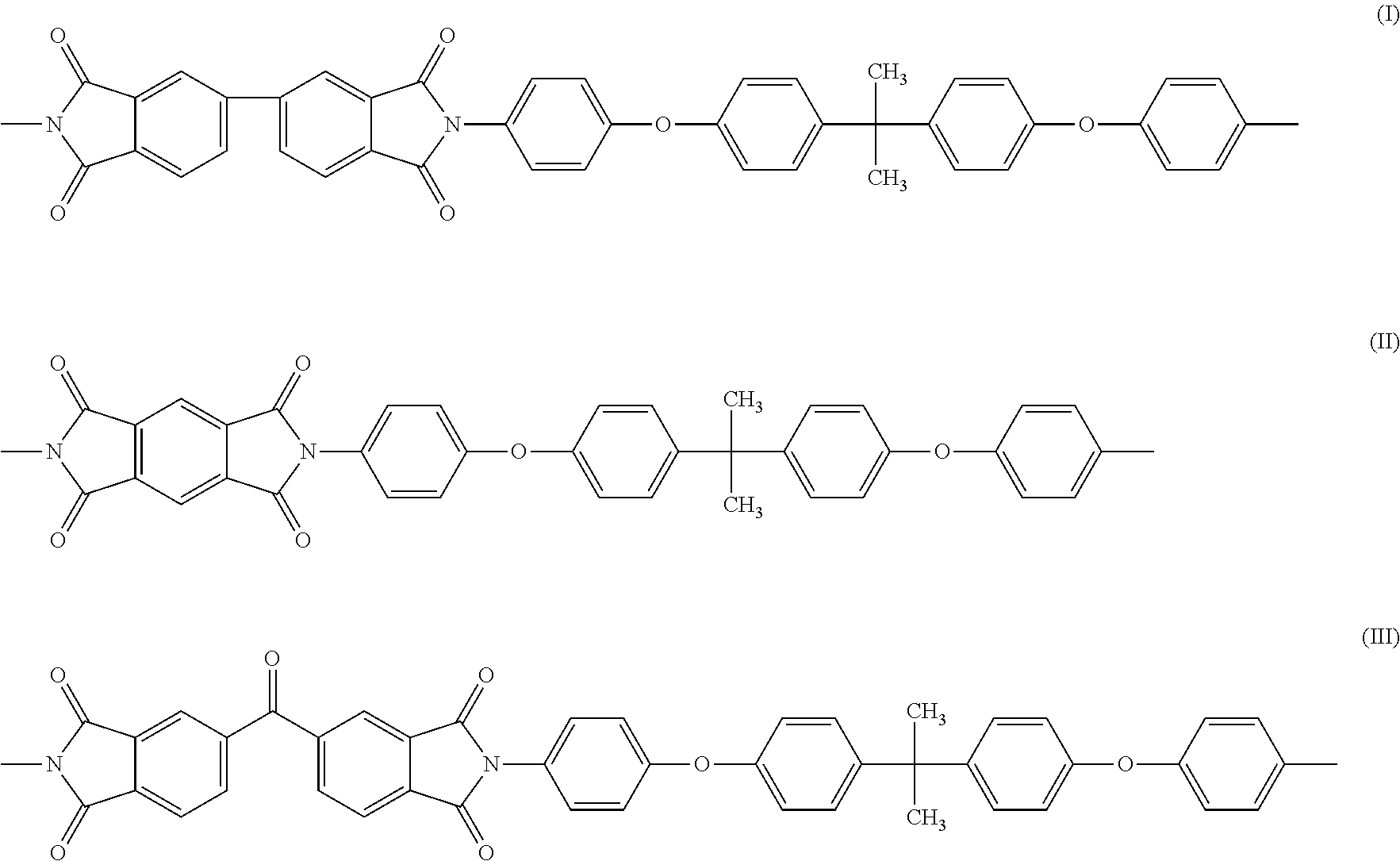Resin composition for printed circuit board
a technology of printed circuit board and composition, which is applied in the direction of synthetic resin layered products, solid-state devices, woven fabrics, etc., can solve the problems of deterioration in the accuracy of forming fine circuits, deterioration of position accuracy and adhesion strength of circuits, and the tendency of projecting parts to remain on the resin surface of the lamina
- Summary
- Abstract
- Description
- Claims
- Application Information
AI Technical Summary
Benefits of technology
Problems solved by technology
Method used
Image
Examples
synthetic example 1
[0068]A four-necked 1000 ml flask equipped with stainless-steel agitating blades, nitrogen duct, a Dean-Stark with cooling tube, and a thermometer was loaded with 41.06 g (100 mmol) of 2,2-bis{4-(4-aminophenoxy)phenyl}propane (hereinafter called BAPP), 100 g of NMP, 12 g of toluene, and 0.51 g of triethylamine, and the content was agitated at 100 rpm under a nitrogen atmosphere. To the resultant solution, 2.18 g (10 mmol) of pyromellitic dianhydride (hereinafter called PMDA), 26.48 g (90 mmol) of 3,4,3′,4′-biphenyltetracarboxylic dianhydride (hereinafter called BPDA), and 100 g of NMP were added each in a mass, and the mixture was agitated at room temperature for one hour, and heated in oil bath for about 20 minutes until the temperature in the reaction system reaches 180° C. Distilled components were captured while the temperature in the reaction system was maintained at 180° C. for 30 minutes, after which the temperature in the reaction system was decreased to approximately 130° C...
synthetic example 2
[0069]A four-necked 1000 ml flask equipped with stainless-steel agitating blades, nitrogen duct, a Dean-Stark with cooling tube, and a thermometer was loaded with 32.85 g (80 mmol) of BAPP, 80 g of NMP, 6 g of toluene, and 0.41 g of triethylamine, and nitrogen under atmosphere, 100 rpm the content was agitated at 100 rpm under a nitrogen atmosphere. To the resultant solution, 5.23 g (24 mmol) of PMDA, 16.48 g (56 mmol) of BPDA, and 80 g of NMP were added each in a mass, and the mixture was agitated at room temperature for one hour, and heated in oil bath for about 20 minutes until the temperature in the reaction system reaches 180° C. Distilled components were captured while the temperature in the reaction system was maintained at 180° C. for 30 minutes, after which the temperature in the reaction system was decreased to approximately 130° C. The reaction system was then mixed with 405.0 g of NMP under agitation to form a homogenous solution, and air-cooled to almost reach room temp...
synthetic example 3
[0073]A four-necked 1000 ml flask equipped with stainless-steel agitating blades, nitrogen duct, a Dean-Stark with cooling tube, and a thermometer was loaded with 32.85 g (80 mmol) of BAPP, 80 g of NMP, 6 g of toluene, and 0.41 g of triethylamine, and the content was agitated at 100 rpm under a nitrogen atmosphere. To the resultant solution, 7.73 g (24 mmol) of 3,3′,4,4′-benzophenone tetracarboxylic dianhydride (hereinafter called BTDA), 16.48 g (56 mmol) of BPDA, and 80 g of NMP were added each in a mass, and the mixture was agitated at room temperature for one hour, and heated in oil bath for about 20 minutes until the temperature in the reaction system reaches 180° C. Distilled components were captured while the temperature in the reaction system was maintained at 180° C. for 30 minutes, after which the temperature in the reaction system was decreased to approximately 130° C. The reaction system was then mixed with 347 g of NMP under agitation to form a homogenous solution, and a...
PUM
| Property | Measurement | Unit |
|---|---|---|
| temperature | aaaaa | aaaaa |
| temperature | aaaaa | aaaaa |
| temperature | aaaaa | aaaaa |
Abstract
Description
Claims
Application Information
 Login to View More
Login to View More - R&D
- Intellectual Property
- Life Sciences
- Materials
- Tech Scout
- Unparalleled Data Quality
- Higher Quality Content
- 60% Fewer Hallucinations
Browse by: Latest US Patents, China's latest patents, Technical Efficacy Thesaurus, Application Domain, Technology Topic, Popular Technical Reports.
© 2025 PatSnap. All rights reserved.Legal|Privacy policy|Modern Slavery Act Transparency Statement|Sitemap|About US| Contact US: help@patsnap.com



